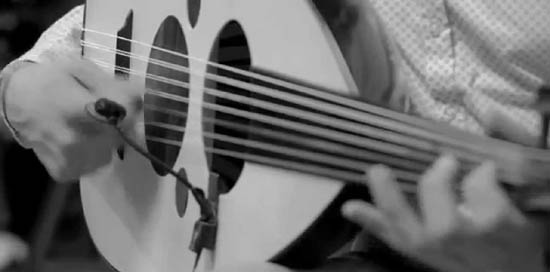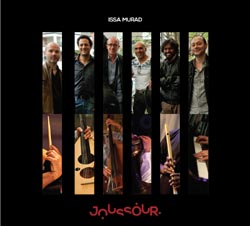|
Issa Murad, a Bethlehem native, developed his chops (oud and voice) at the Edward Said National Conservatory of Palestine, furthering his career in Cairo for a couple of years before moving on Paris in 2007, where he wrote an ethnomusicology thesis at the Sorbonne and dove into the city's cosmopolitan musical milieu. In Paris, Murad formed the ensemble Joussour in 2012 as an experimental sextet whose Arabic meaning is “bridges,” an apt metaphor for his compositions, which explore connections between the improvisatory bent of Arabic, Syrian, Turkish, Balkan, Indian, Latin and world jazz sonorities. Collaborating in Murad's sonic revelations are Parisian jazz stalwarts Richard Turegano (piano), Marc Buronfosse (double bass), and Frédéric Chapperon (drums, percussion), along with New Delhi native Rishab Prasanna (bansouri, voice) and Syrian percussionist Samir Homsi.
The music's Levantine roots are manifest, but this is a heterogeneous, forwarding-looking project that draws easily upon, but is not bound by, any of its traditional inspirations. This is in fact the way that musical collaboration always has unfolded across genres and cultural forms whose affinities need to be unearthed via close listening, practice and reflection.
Murad's dazzling oud work is manifest, meshing fluidly with Prasanna's flute and vocals and Homsi's polyrhythmic underpinnings, extending the Levantine feel east along the Romani road linking the Indian subcontinent with the West, where, in Paris, if the instrumentation is unfamiliar to North American ears, jazz improvisation has long engaged with its more easterly roots.
While certainly distinct from, say, such classics as Randy Weston's many readings of Morocco, Yusef Lateef's Eastern Sounds (1962), or Coltrane's “India” (Impressions, 1962), with tunes like “Houroub,” “The Mysterious Person,” or “Yanayer,” Murad and company demarcate common ground between traditions that might strike casual listeners—perhaps especially North American jazz aficionados—as distant in geographical and historical terms. All the more reason, then, to listen up and break out of the conservatory turn and technical fetishization that have colonized U.S. jazz in recent decades. As this uncommon title confirms, there's a world of illuminating improvisation out there, awaiting those who seek a different kind of different.
The handsomely designed hardcover package includes photos, illustrations and brief notes in French, Arabic, and English.—Michael Stone
Find the artist online: www.issamurad.com
|

